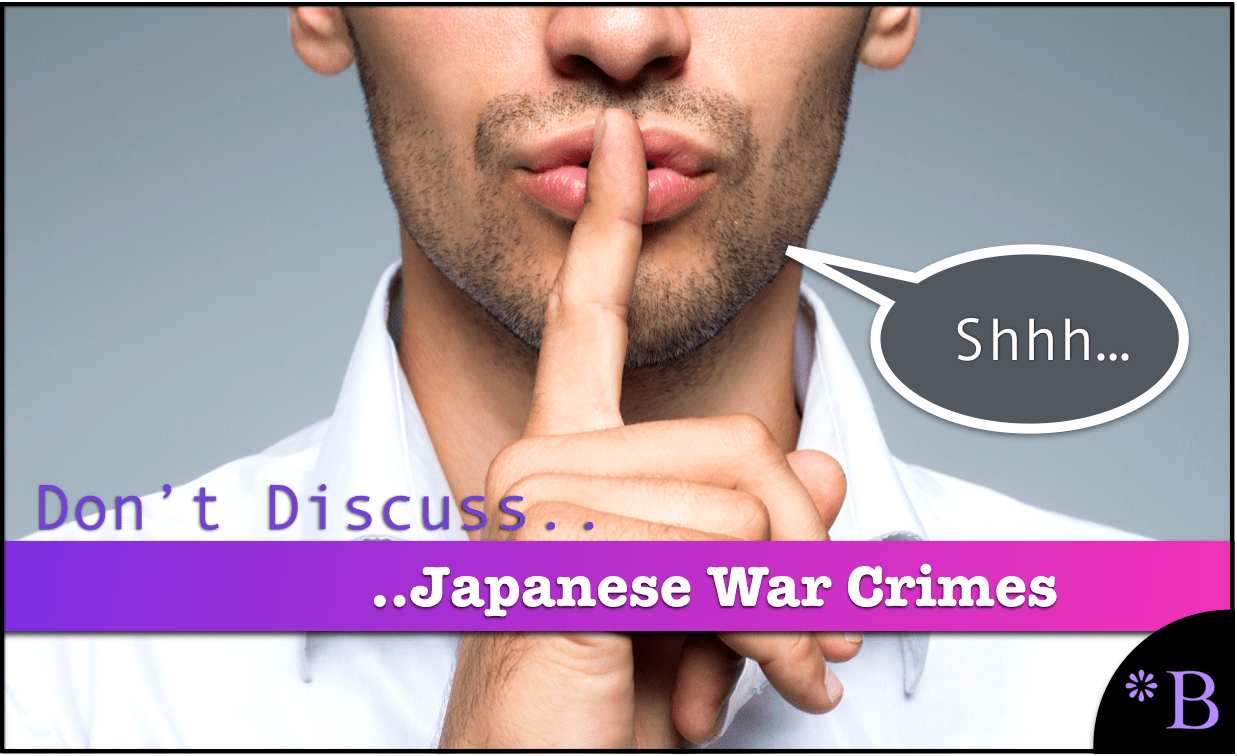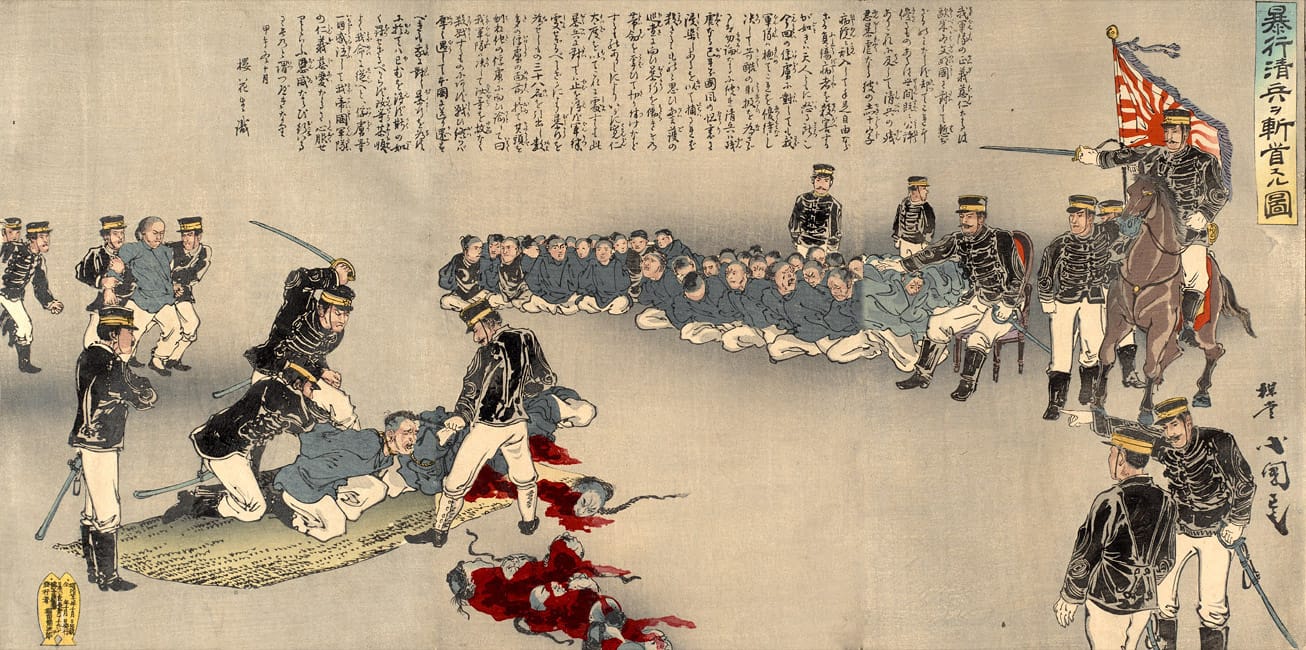Have Japan’s War Crimes Been Historically Deemphasized Because They Are Not White?
Executive Summary
- The Japanese engaged in horrendous war crimes for many decades, including WW2.
- Why were these war crimes covered up?

Introduction
For decades the Japanese engaged in horrific war crimes, yet these crimes are little discussed. How did Japan manage to have its war crimes de-emphasized?
Our References for This Article
If you want to see our references for this article and other related articles at any time, visit this link.
The Long Term Pattern of Atrocities by the Japanese
Most people think of Japanese atrocities as only lasting through the war, which is generally believed to be from 1941 to 1945, ending in the defeat of Japan, Italy, and Germany. However, this is not accurate. Japan was at war over many decades and committed atrocities during these wars. The Nazis were a very significant break from German history, an anomaly. During WWI, the Germans were engaging in a war similar to the French and English. However, the wartime atrocities of the Japanese during WW2 were just a continuation of a long-term pattern of behavior. The following quote describes some of this behavior.
As Japan met resistance in conquering China, the Nanjing blueprint was applied to the whole country. Surveying the aftermath of the war in 1945, researcher Gavan McCormack described a landscape of torched villages, “people-reducing kilns” (which the Japanese called renjiro) and mass graves, or “ten thousand people pits” (bajinkō). – Medium
Scientific Experimentation
The Japanese atrocities generally were at least as bad as anything performed by the Nazis, with the Nazis treating prisoners of war far more ethically than the Japanese.
The Japanese Obsession With Beheading
The Japanese military had a strange obsession with beheading people they had captured, military or civilians.

Source: Utagawa Kunimasa V – Sharf Collection, Museum of Fine Arts.
The Japanese military has a long history of beheading helpless PWOs, which illustrates similarities with another barbaric culture in Saudi Arabia. This image depicts a scene from the late 1800s during the Sino-Japan War.
Beheading was just the tip of the iceberg. Throwing babies on bayonets, mutilation, starvation, no treatment was too vicious for the Japanese military. The Japanese military considered this type of behavior “honorable.” Someone, this barbarism was justified through a “code of honor.”
The Treatment of POWs
The treatment of POWs by the Japanese is explained in the following quotation.
Japan forced POWs to endure 130-mile death marches and forced labor on war-related projects. They were denied adequate food, water and medical care. They were beheaded, or used as targets for rifle and machine gun practice.
Japan treated its POWs even worse than the Nazis: After the war, tribunals found that Japan had interned some 350,000 prisoners of war. An estimated 27% of Allied POWs died in captivity, compared to a mere 4% of POWs who died in German and Italian captivity. – Medium
This mistreatment was partly due to the Japanese Bushido code, which is explained as follows.
The result was that the Bushido code of behavior “was inculcated into the Japanese soldier as part of his basic training.” Each soldier was indoctrinated to accept that it was the greatest honor to die for the Emperor and it was cowardly to surrender to the enemy. … Bushido therefore explains why the Japanese soldiers who were stationed in the NEI so mistreated POWs in their custody. Those who had surrendered to the Japanese—regardless of how courageously or honorably they had fought—merited nothing but contempt; they had forfeited all honor and literally deserved nothing. Consequently, when the Japanese murdered POWs by shooting, beheading, and drowning, these acts were excused since they involved the killing of men who had forfeited all rights to be treated with dignity or respect. While civilian internees were certainly in a different category from POWs, it is reasonable to think that there was a “spill-over” effect from the tenets of Bushido. – Wikipedia
Bushido is an entirely barbaric code that endorses cruel abuse and is at its core psychotic.
The Japanese Were Forced into a War With the US by US Provocation
To minimize their responsibility, many Japanese promote the idea that the Japanese were forced into war through the actions of the US. These actions included the following.
“On July 2, 1940, Roosevelt signed the Export Control Act, authorizing the President to license or prohibit the export of essential defense materials.” Under this authority, “[o]n July 31, exports of aviation motor fuels and lubricants and No. 1 heavy melting iron and steel scrap were restricted.” Next, in a move aimed at Japan, Roosevelt slapped an embargo, effective October 16, “on all exports of scrap iron and steel to destinations other than Britain and the nations of the Western Hemisphere.” Finally, on July 26, 1941, Roosevelt “froze Japanese assets in the United States, thus bringing commercial relations between the nations to an effective end. One week later Roosevelt embargoed the export of such grades of oil as still were in commercial flow to Japan.” – Mises.org
The Export Control Act was signed in 1940, although the US enabled restrictions on the Japanese as early as 1938. However, the Rape of Nanking was in 1937. Images of the Rape of Nanking can be viewed at this site.
Was the US supposed to continue trade and provide financial interaction with a country that engaged in mass war atrocities? Defenders of Japan use the term “provoke” quite liberally. If the US did not interfere with and support Japan’s continual war atrocities in Asia, it would be “provoking” Japan.
Furthermore, the war with China began before 1937, in 1931, and the Japanese engaged in their typical atrocities all through this time. The number killed by the Japanese has an extensive range, from 20 million to 50 million.
Japan And Its Factories of Sex Slavery
The Japanese created an enormous system of sex slavery. The term used was “comfort women,” and these women were often raped 40 times per day. Hundreds of thousands of comfort women, some as young as 11 years old, were kept at thousands of these rape locations to service the massive Japanese military. Here is one example of how it functioned.
By one estimate, 20,000 women were raped. “So that we will not have any problems on our hands,” one company commander told his men, “either pay them money or kill them in some obscure place after you have finished.” – Medium
The Japanese view on sex slavery is very reminiscent of the Muslim perspective, which I cover in Islam, and the Constant Motivation of Sex and Sex Slavery.
Despite its atrocities, Japan managed to make itself the victim of WW2.
Unit 731 conducted the most horrific scientific experiments versus captured Asians. Emperor Hirohito approved the creation of this “lab.” Unit 731 was one of many Japanese atrocity labs that were in operation. The Japanese committed so many atrocities it’s hard to keep track of, but here are a few links to atrocities that were noteworthy.
Estimates of those who were killed by Unit 731 and its related programs range up to half a million people.
Prisoners were injected with diseases, disguised as vaccinations,[23] to study their effects. To study the effects of untreated venereal diseases, male and female prisoners were deliberately infected with syphilis and gonorrhea, then studied. Prisoners were also repeatedly subject to rape by guards.
Thousands of men, women, children and infants interned at prisoner of war camps were subjected to vivisection, often without anesthesia and usually ending with the death of the victim.
Prisoners had limbs amputated in order to study blood loss. Those limbs that were removed were sometimes re-attached to the opposite sides of the body.
In other tests, subjects were deprived of food and water to determine the length of time until death; placed into low-pressure chambers until their eyes popped from the sockets; experimented upon to determine the relationship between temperature, burns, and human survival; pumped full of horse blood; hung upside down until death; crushed with heavy objects; electrocuted; dehydrated with hot fans;[46] placed into centrifuges and spun until death; – Wikipedia
During the Kanto Massacre, the “According to multiple reports from Japanese witnesses, beginning on the night of September 2 police officers in Yokohama, Kanagawa and Tokyo began informing residents that it was permissible to kill Koreans. Some orders were conditional, such as killing Koreans who resist arrest, but others were more direct: “kill any Koreans who enter the neighborhood” or “kill any Koreans you find.” Books denying the massacre and repeating the government frame story of 1923 became constant bestsellers in the 2010s.[23] In April 2017, the Cabinet Office deleted historical evidence and acknowledgement of the massacre from their website. After the massacre, Navy Minister Takarabe Takeshi praised the Japanese lynch mobs for their “martial spirit,” describing them as a successful result of military conscription.[5]: 114 Paper plays called kamishibai were performed for children which portrayed the slaughter with vivid, bloody illustrations. Performers would encourage children to cheer for the lynch mobs as they killed “dangerous” Koreans. – Wikipedia
The Japanese Do Not Care And Are Not Taught About the Crimes of the Japanese Military
In Asian culture, it is virtually impossible for a country to take responsibility for one’s actions. Therefore, the Japanese do not teach anything about these atrocities. Most Japanese see the country as a victim of WW2, as they were heavily bombed during the war.
With the enormity of war crimes committed by the Japanese, it is shocking how few were ever tried for these crimes. This is explained in the following quotation.
Only 28 Japanese military and government officials were tried at the Tokyo War Crimes Tribunal in 1946. (The tribunal was overseen by the US.) Three died during trial. The other 25 were found guilty. Of those, 7 were hanged and 18 were sentenced to prison terms, but were pardoned by 1958. – Medium
That by itself is amazing. Why were not all of them immediately hanged? Japan had many thousands of war criminals, and almost all of them got off scot-free.
Scandalously, in 1959, Japan’s Emperor Hirohito ordered the names of the war criminals added to a shrine in Tokyo where Japanese have traditionally memorialized their fallen fighters. – Medium
Obviously, this means that even the worst war criminals are not viewed as war criminals by the Japanese themselves. In Japan, they have been referred to as the “Martyrs of Shōwa.” According to the Japanese, war criminals guilty of the most heinous acts imaginable are martyrs.
Hirohito did this, without any concern for blowback if it was learned that he did this. In Japan, any atrocity, from beheadings to mass rape, to horrific experimentation is acceptable if it is done by the Japanese against non-Japanese. That is, there is no war crime if it is done by a Japanese person. And not only that Japanese war criminals are the “greatest leaders.”
“I have a special appreciation for the families of our war criminals,” Hirohito said in a benediction. “I know what they have done for Japan. They were among our greatest leaders.” – Medium
Estimates of the Total Killed by the Japanese
The total killed by the Japanese, not only during WW2, but leading up to it is mind-boggling. This is one estimation.
The numbers of the democides of the 20th century are Nazi Germany: ~12 million
Soviets (Stalin): ~17 million
Imperial Japan: ~20 million,
PRC (Mao): 50–90 million (PRC has not cooperated in refining this number). – University of Hawaii
How Japan Dodged Culpability for WW2
Something very peculiar happened after WW2, because Japan as a country was never held accountable for their actions anywhere near as much as the Germans and the Russians. After committing decades of atrocities, the only thing most Japanese seem interested in discussing is the bombing of Hiroshima and Nagasaki. The question to be asked is why Japan was allowed to recast itself as at least a partial victim of WW2.
There is an established pattern I have documented on this website, which is the double standard when it comes to accountability depending up whether the individuals in question are white. This is also explored in the article Is It Slavery If The Slave Owner Is Not White? This article makes the observation that there is modern-day slavery worldwide, which is accepted but only in non-white countries.
Were The Japanese Not Held Accountable for Their Atrocities Because They Are Not White?
There is a valid question whether the war crimes and horrendous behavior of the Japanese during WW2 (and many wars before this) have been whitewashed because it is not considered politically correct to hold non-whites accountable for barbaric behavior or a complete lack of ethics. We hear about the atrocities of the Nazis without end, as they are kept alive in movies, while the atrocities, which in many dimensions exceeded that of the Nazis, are barely mentioned. Both Germany and Japan were heavily bombed during the war, yet only the Japanese are considered victims. The Japanese are not only guilty of these war atrocities, but also for positioning themselves as victims of the war, for being entirely unconcerned with those they killed and mutilated, and for doing everything they could to cover up their atrocities. That is the Japanese were not just horrendously unethical, their lack of ethics continued for decades, and to the present day as they have refused to take any ethical responsibility for their behavior.
Our Golden Pinocchio

Those who discuss Japan in glowing terms hide its history of occupation and atrocities and do not hold Japan or the Japanese to any ethical standard because they are not white.